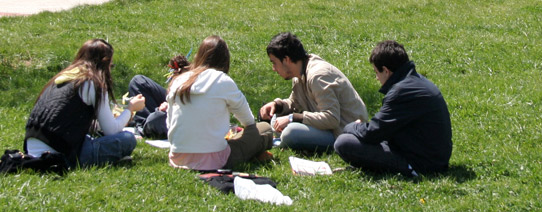|
|
 |

Tourist attractions in Santiago
-
Facing the Fuente de los Caballos from the lower side of the square is the ornamental 18th-century Casa do Cabildo, a residence for cathedral clergy.
-
Anyone who has journeyed along the Camino de Santiago will hardly be disappointed on finally entering Praza do Obradoiro to behold the lavish baroque façade of the Catedral del Apóstol. Before this elaborately festive façade was built in the 18th century, the less overwhelming but artistically unparalleled Pórtico de la Gloria (Galician: Porta da Gloria) - now behind the baroque façade - was the first scene to greet weary pilgrims.
-
To the right of the cathedral's façade is the main entrance to the Cathedral Museum. The museum includes the cathedral's claustro (cloister ; inside this entrance), treasury and crypt, and the Pazo de Xelmírez on the north side of the cathedral.
-
Facing the Museo de Pobo Galego, the Centro Galego de Arte Contemporánea hosts exhibitions of modern art.
-
About 1km south of the old town along Rúa do Patio de Madres stands, precariously (it suffers a pronounced tilt), the Romanesque Colexiata de Santa María do Sar. Part of the beautiful cloister can still be admired and there's a small museum, mainly of Romanesque sculpture.
-
Colexio de Fonseca, the original seat of Santiago's university (founded in 1495), has a beautiful courtyard, university library and exhibition gallery.
-
However much the cathedral dominates the heart of Santiago, the area around it is rich in other architectural jewels. The Renaissance Hostal dos Reis Católicos stretches across the northern end of Praza do Obradoiro. Built to shelter the poor and infirm by Isabel and Fernando, it now shelters well-off travellers instead, as a parador(luxury, state-owned hotel).
-
Keep following the cathedral walls northwards to reach Praza da Inmaculada. Rising up on the far side is the huge Benedictine Mosteiro de San Martiño Pinario. The classical façade hides two 17th-century cloisters which are normally closed, except in the summer when the monastery opens as lodgings for tourists and pilgrims.
-
Across the plaza from the Puerta Santa is the long, stark wall of the Mosteiro de San Paio de Antealtares, founded by Alfonso II for Benedictine monks to look after St James' relics, and converted to a nunnery in 1499.
-
Museums worth seeking out include the Museo das Peregrinacións, devoted to the Camino de Santiago phenomenon over the centuries.
-
Northeast of the old town, the former Convento de San Domingos de Bonaval houses the Museo do Pobo Galego, with exhibits on Galician life and arts, from the fishing industry to music and traditional costumes. The monastery's Gothic church is part of the visit, but the most singular feature of all is the triple spiral staircase.
-
The Museo Granell has an impressive collection of surrealist art based on the work of Galicia's Eugenio Granell.
-
Along the western side of the Praza do Obradoiro is the elegant 18th-century Pazo de Raxoi, now the city hall.
-
A stroll around the cathedral takes you through some of Santiago's most inviting squares. To the south is Praza das Praterías , with the Fuente de los Caballos (1829) at its centre. The cathedral's south façade, up the steps, is an original, if weathered, Romanesque masterpiece.
-
Following the cathedral walls you enter Praza da Quintana. Here is the cathedral's Puerta Santa, opened only in holy years when the Feast of Santiago (25 July) falls on a Sunday.
Go back to Learn Spanish in Santiago
|
 |
|

